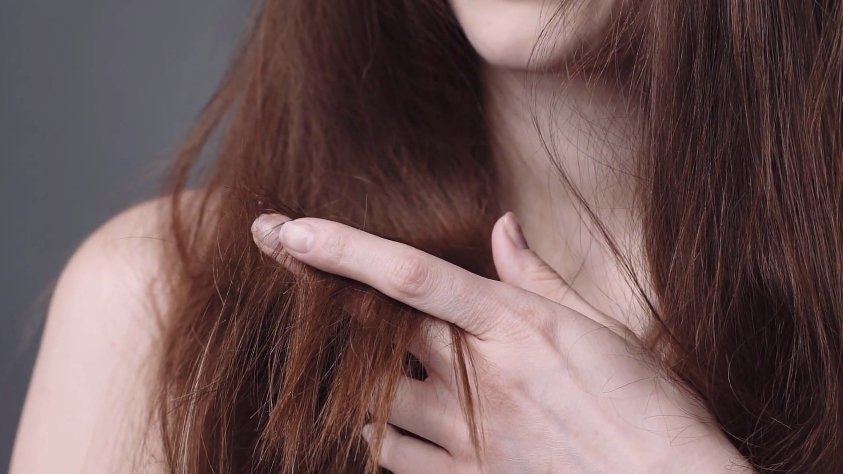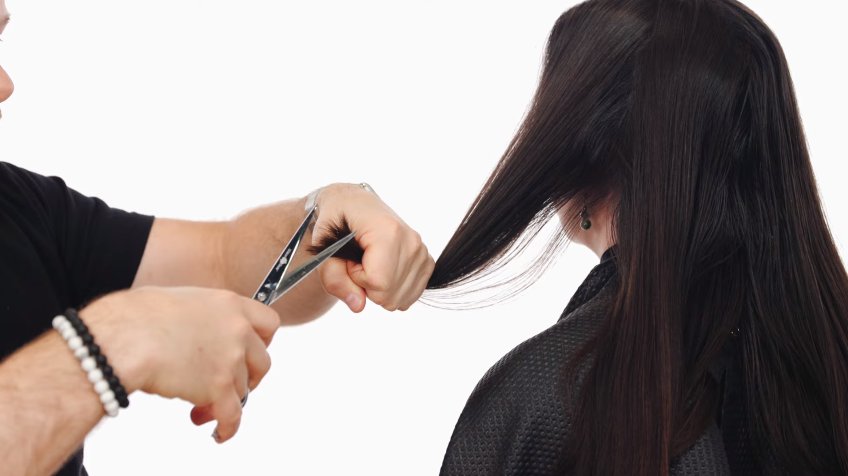Split ends refer to the splitting or fraying of the hair shaft, most commonly affecting long or curly hair. In simple terms, the split ends are caused by repetitive damage to your hair through combing, braiding, or hot styling tools. The damage is caused by a chemical reaction in your scalp that breaks down the protein, allowing these split ends to form.

Don't let split ends get the best of your locks! Know your types and tackle them head on.
1. The Basic Split
The basic split is the most common type of split, and you'll see it in almost every woman's hair. The split ends are caused by dehydration and over-drying your hair. It looks like a regular split end, with a bend at the base, but it gets larger as it travels up your strand. This type of split ends up on its own because it's not as severe as other types of the split. Or it can be fixed by cutting out the damaged part.
2. The Baby Or Mini Split
A baby or mini split is similar to a basic split but occurs on shorter lengths of hair (like an inch). This can happen when you use too much heat during styling, such as blow drying or straightening your hair with a flat iron or curling iron without using protective styling products (like a serum or spray). It also happens when you wash your hair too frequently, which strips away vital moisture that keeps split ends from forming in the first place!
3. The Triangle Or Fork Split
This type of split shows up as three small triangles that are spaced evenly apart along each strand of hair (the "triangles" look like forks). This usually happens after regular washing routines because water strips away moisture from your scalp.
The Triangle or Fork Split is a more serious type of split end because it can break down your hair's structure. These splits generally require cutting and re-growing and deep conditioning treatments to repair their damage.
4. The Tree Split
Another common type of split is the tree split, also known as a multi-branched split. A tree split occurs when the hair is too long, and the cortical cells begin to separate. This is usually seen in African-American hair, but it can be seen in any hair as a result of over-processing and excessive weathering.
For example, if you have dyed your hair a lot and then tried to dye it again, this will often cause the tree split end. It's also possible to get this split end after using hot tools like blow dryers or flat irons on wet hair.
5. The Feather Split
The feather split is also known as a "mid-shaft" split. This type of split occurs on one side of your hair and looks like a "feather" or "little feather." It occurs at the midpoint of the hair shaft, just above, where it begins to taper down.
This type of split is often caused by over-processing or over-styling techniques that result in too much moisture in your hair, which causes it to snap or snap off at that point. You can avoid this type of split by using products and techniques that reduce frizz and flyaway hairs without causing any damage to your hair's structure or integrity.
6. The Crinkle Split
The next type of split end is called a crinkle split. These look similar to feather splits, but they are wider and usually appear on the edges of your hair instead of at the root. These types of split ends are usually caused by dryness, excessive coloring, environmental pollutants, and hair being stretched to frequent breaking points.
7. The Mid Shaft Split (Incomplete Split)
Mid-shaft splits are another form of split ends resembling a "half-moon" shape, with one side longer than the other. This type of split appears as a horizontal line down the middle. These splits happen from wet combing/brushing, wearing hair in too-tight styles for extended periods, and excessive heat styling.
What Causes Split Ends?

Damaged hair? Find out what's causing your split ends and how to fix them.
1. Hair coloring
The most common cause of split ends is hair coloring. When you dye your hair, the chemicals in the product can react with the cuticle, causing it to break and split. In addition, when you dye your hair, the color molecules penetrate your hair shafts and strip the natural oils out of your hair, and make it dry and brittle. This damage can also occur if you over-color your hair, as too much dye can cause a lot of friction when brushing or combing your hair.
2. Pollution
Air pollution can cause your hair to become brittle, dry, and break off easily. Pollutants in the air act as a catalyst on your hair follicles, causing them to become damaged over time. The chlorine in swimming pools can be absorbed by your hair, causing it to become damaged and dry.
Similarly, air pollution from traffic fumes and industrial emissions can also negatively impact your scalp's health by breaking down proteins. Dry, brittle hair is prone to split ends or breakage if you don't take care of it properly after washing it often enough!
3. Over-Washing
Another major cause of split ends is over-washing. Shampooing too often can strip away natural oils from your scalp, which leads to dryness and irritation, as well as split ends on the ends of your hair shafts (the part you see). If you're not shampooing frequently enough —or using a product that doesn't work well with your type of hair —then this could lead to chronic dandruff or even an Itchy Scalp Syndrome flare.
4. Heat styling
Heat styling can cause split ends because it heats up the cuticle layer of your hair, which causes its outer layers to curl up around itself and create micro-folds in its protein matrix (or cortex).
These micro-folds make it more prone to breakage as well as make it more difficult for new growth cells to enter through the damaged cortex and heal naturally over time!
5. Chemical treatments
Split ends are caused by chemical reactions from perming, straightening, or bleaching your hair. Disulfide bonds give the hair its natural shape and strength. Perms and relaxers break down the disulfide bonds in the hair. When these are broken the hair loses its natural strength, resulting in split ends.
How To Prevent Split Ends

Sick of dealing with split ends? Discover the causes and solutions here.
- Keep your hair healthy by washing it daily and using conditioner, even if you don't need it.
- Avoid shampoos with harsh ingredients, such as sulfates, parabens, and chlorine. These ingredients strip away natural oils in your hair and leave it more susceptible to split ends.
- Avoid brushing your hair when wet, which causes the cuticle to stretch.
- Be careful when combing and brushing your hair, removing the hair with your fingers if necessary.
- Don't blow dry your hair too much. Blow drying removes moisture from your hair, leading to dryness and breakage.
- If using a hair dryer, use the cool setting or just let your hair air dry after washing.
- Don't use harsh products on your hair, such as bleach or straighteners, which will break down your hair shaft and cause split ends in the first place.
- Trim the split ends regularly (at least every 4 weeks)
- If you're going to get a haircut, ask for a trim that doesn't cut too short or too close to the scalp so that split ends won't form on top of your head where they can be more noticeable.
- Always seek professional help or advice when using chemicals such as hair dyes and relaxers.
- Get a protein treatment and hair spa to prevent your hair from damage and split ends.
So, you should thoroughly understand split ends, which will help you identify and prevent them. So, we hope this guide will help you completely understand Split End!